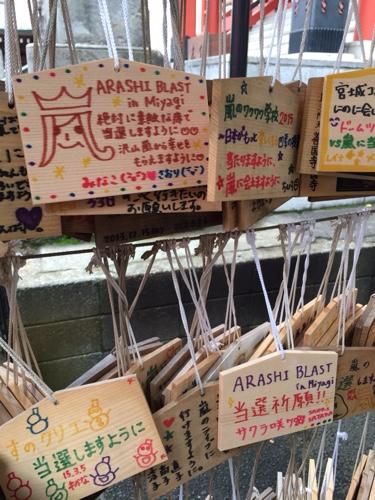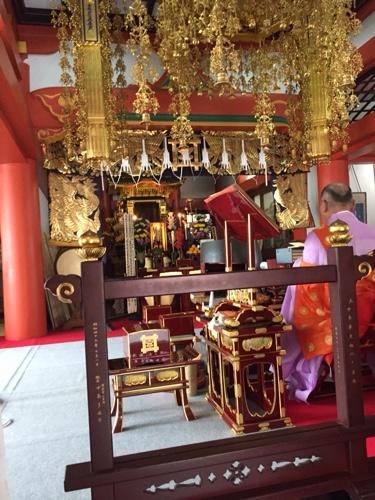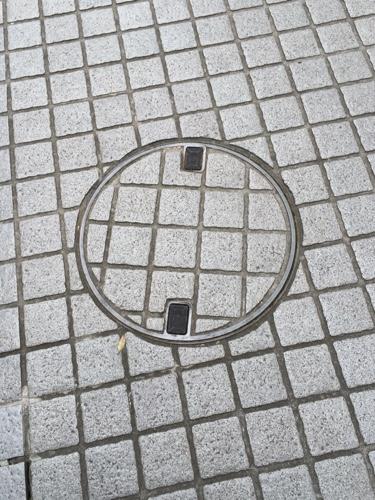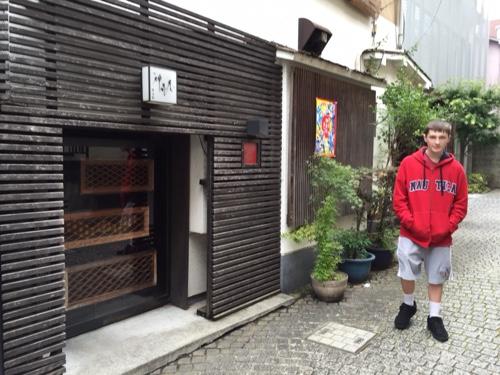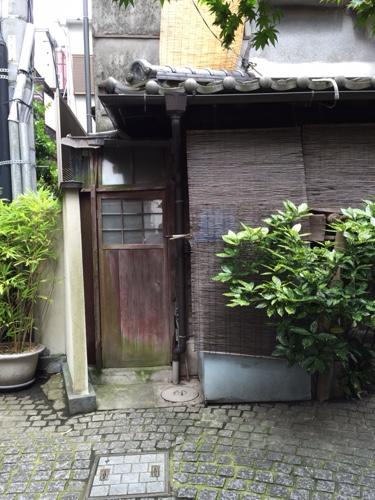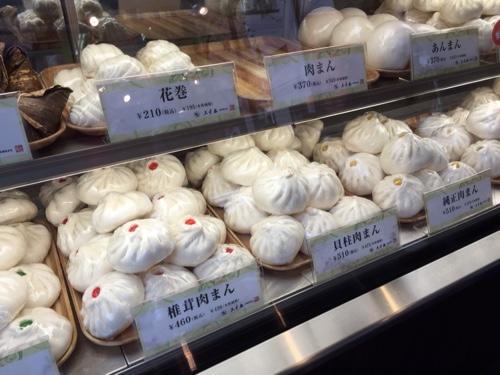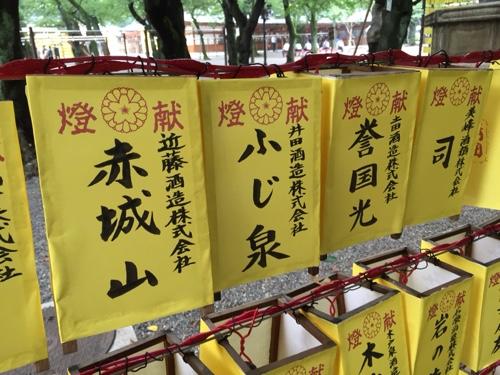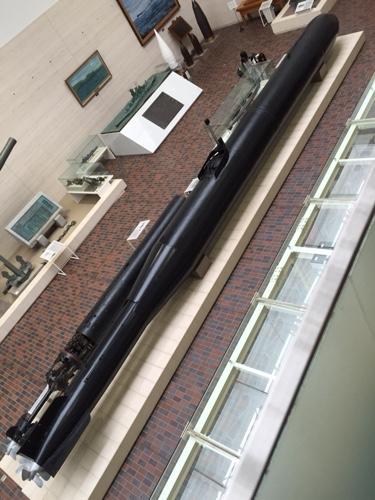While the others had decided to go hiking up Mt Fuji, in the freezing cold, and with massive amounts of rainfall predicted, I decided to take a more sensible approach to my sightseeing activities today and had a great schedule lined up.
First stop was the Tokyo Tower. Tokyo Tower was built in the post war era when Japan was trying to re-create itself and it’s international identity. It is loosely modelled on the Eiffel Tower but is apparently 13m taller – thems was some pretty important 13m at the time I am sure. Apparently the bright orange colour is due to aviation requirements and given the foggy and hazy weather we have been having since we got here, I can well understand why that particular regulation is in place. It is an unapologetic tourist trap – complete with super fast lift with flashing whizz bang lights in the ceiling (The Rock anyone?) and an observation deck at 150m that gives some great views over Tokyo. At the bottom, there is a huge selection of rip off souvenir shops, an aquarium and a small wax museum. Worth it for the views, but I just skipped out on the rest. 🙂 One of those things that you enjoy if you just accept it for what it is, I think.

 The view from the observation deck is quite interesting, even on this day of pretty crappy weather. This shrine has a famous cemetery where six of the last Shogun samurai were interred… cemeteries here seem to be less accessible and definitely not photo friendly from what we have seen so far – quite the opposite of New Orleans and Arlington on our last trip where you paid an admission fee and got the guided tour. The tower also has some of those freaky glass bottom floor sections so you can see just how far down it is. To be honest, looking over the railing in our apartment building is more stomach lurching than this was… perhaps something to do with the repetition, but it looks like the floors go down indefinitely.
The view from the observation deck is quite interesting, even on this day of pretty crappy weather. This shrine has a famous cemetery where six of the last Shogun samurai were interred… cemeteries here seem to be less accessible and definitely not photo friendly from what we have seen so far – quite the opposite of New Orleans and Arlington on our last trip where you paid an admission fee and got the guided tour. The tower also has some of those freaky glass bottom floor sections so you can see just how far down it is. To be honest, looking over the railing in our apartment building is more stomach lurching than this was… perhaps something to do with the repetition, but it looks like the floors go down indefinitely.

Our next stop was to the famous Hama-rikyu Gardens, favourite spot for Shinto weddings apparently – we were greeted by a policeman sitting in a police box. According to Atsushi, our host and tour guide extraordinare, Japan has an extremely low crime rate of 1.5% (percent of what I want to know?!) and the police in his box, well, he is ‘waiting for crime’. The gardens are lovely. Well manicured and lovingly kept, there are beautiful little tea houses where we go to meet a master of the tea ceremony who is called Sensai (teacher). The Sensai was not what I was expecting, a mature woman of delicate features whose movements were well practiced and elegantly executed.
Authentic powdered green tea used by samurai warriors ‘for the dizzies’, which turns out meant they used it as a hangover cure because of its high caffeine content. The sensai makes us tea according to the rituals, and we in our turn execute our part of the ritual. A cup is placed before us, we pick it up with our right hand, cupping it underneath with the left, and then using our right hand rotate it clockwise to move the pictured side of the cup away from where we will drink from. Your first sip is deep, and followed by more smaller sips… until the last sip which must be taken with an audible slurp noise. We then wipe the edge of the cup with the index finger and thumb before turning the cup counter clockwise so the picture faces ourselves again and we may then put the cup down. The tea Sensai will then ask, ‘How was your tea?’ to which we are required to bow, and answer ‘kekodesu’, meaning excellent. It is apparently part of the ceremony to respond ‘excellent’ even if you dislike the bitter taste so as not to offend the sensai and her years of training. 🙂
After leaving the teahouse, we have some time to explore the famous gardens, absolutely beautiful and so peaceful. You would never know you are in the middle of one of the world’s biggest cities. There were koi about 30-40cm long in a beautiful pond, and a row of bonsai trees, the oldest of which was 520 years old. Even though it was raining today, the gardens had a beautiful fresh and rainforest like look about them, or perhaps it was because it was raining today that it felt like that…





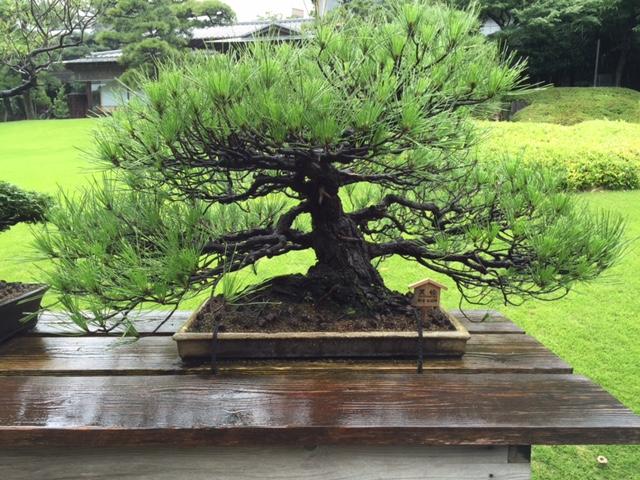

Next we moved onto a Japanese BBQ lunch at the Hotel Chinzanso Tokyo, which is also set in some amazing gardens. The Japanese BBQ here is cooked on a flat piece of rock cut from lava up at Mt Fuji, and is heated using a gas system and cooked at the table for us. I had lunch with a lovely lady named Melody (not her real name, Anglicised version of a name she didn’t bother telling me because none of her English friends could pronounce it anyway!) who came from a ‘small town’ in Southern China called Spring City… her ‘small town’ by the way which has a population of ‘only 20 million people’. Jesus, that’s almost the population of Australia.
Lunch was a lovely combination of pork, wagu beef, eggplant, onion, carrot, potato, all cooked on the lava stone, and rice, salad and topped off with green tea gelato/ice cream (not sure which, not creamy enough to be ice cream, not icy enough to be gelato!). And a lovely stroll through the gardens on the way out to our pick up, Atsushi, who said to us ‘Thank you for being puncture’ on our return. Love quirks of language… we know what he meant.



 We ran into these lovely ladies dressed in their kimono as we were leaving the gardens, I said hello and said they looked lovely, and a compliment goes a long way as they were happy to allow us to take some photos. Atsushi tells us that formal kimono for a young lady’s ‘coming out’ could cost upwards of USD$10,000 by the time the inner and outer robes, and inner and outer belts (obi), undergarments, shoes, hair ornaments etc were all added in. Which is why most families have these lovely kimono that are passed down from generation to generation. The other interesting thing I learned about kimono today is that both men and women wear them wrapped left over right – if you wear it right wrapped over left, you are probably dead. As in, that is the only time they dress someone that way, for burial.
We ran into these lovely ladies dressed in their kimono as we were leaving the gardens, I said hello and said they looked lovely, and a compliment goes a long way as they were happy to allow us to take some photos. Atsushi tells us that formal kimono for a young lady’s ‘coming out’ could cost upwards of USD$10,000 by the time the inner and outer robes, and inner and outer belts (obi), undergarments, shoes, hair ornaments etc were all added in. Which is why most families have these lovely kimono that are passed down from generation to generation. The other interesting thing I learned about kimono today is that both men and women wear them wrapped left over right – if you wear it right wrapped over left, you are probably dead. As in, that is the only time they dress someone that way, for burial.

 After lunch we head off to the Imperial Palace which is right in the middle of Chiyoda-ku and some absolutely enormous grounds (you have to check that out on Google Maps – it’s huge). Most of the gardens are closed to the public except on January 2nd to welcome in the New Year and December 23rd to celebrate the Emperor’s birthday. The Imperial Palace is not open to visitors either but wandering the East Gardens of the was worth a look-see. Apparently the Palace houses only two members of the Imperial family – the Emperor and the Empress, the rest of their family live in a different palace not far away. There is a staff of 500 body guards to look after the 2 of them, and they are very carefully selected and trained. They must first pass a national exam, then train for 1 year in English, law, both Japanese marital arts – kendo and judo – as well as poetry, calligraphy, dancing, skiing, horse riding “everything they need to guard the Emperor and Empress. Very busy.”
After lunch we head off to the Imperial Palace which is right in the middle of Chiyoda-ku and some absolutely enormous grounds (you have to check that out on Google Maps – it’s huge). Most of the gardens are closed to the public except on January 2nd to welcome in the New Year and December 23rd to celebrate the Emperor’s birthday. The Imperial Palace is not open to visitors either but wandering the East Gardens of the was worth a look-see. Apparently the Palace houses only two members of the Imperial family – the Emperor and the Empress, the rest of their family live in a different palace not far away. There is a staff of 500 body guards to look after the 2 of them, and they are very carefully selected and trained. They must first pass a national exam, then train for 1 year in English, law, both Japanese marital arts – kendo and judo – as well as poetry, calligraphy, dancing, skiing, horse riding “everything they need to guard the Emperor and Empress. Very busy.”

 This is the imposing gravel pathway leading up to the lookout for the Imperial Palace in the middle of the East Gardens, and over the other side of the Uchibori-dori Ave is Shinjuku, which was largely bought up by Mitsubishi a few decades ago and now sells for USD$270,000 per square meter. That’s right – over there real estate is worth a small fortune, the seemingly unused gravel parade ground? Driveway? Mall-that-looks-like-th-Washington-Mall-without-any-monuments? is just laying around doing nothing but providing an impressive walk way for tourists on real estate worth the equivalent of some medium sized African nation’s GDP! Wow… but I did find the guy who has Tokyo’s worst job ever. This dude appears to be raking all these acres of gravel by himself, and the inconsiderate tourists who were running all through it to get the right spots for their photos didn’t even seem to notice this poor guy coming along after them smoothing out their footprints. Crazy. 🙂
This is the imposing gravel pathway leading up to the lookout for the Imperial Palace in the middle of the East Gardens, and over the other side of the Uchibori-dori Ave is Shinjuku, which was largely bought up by Mitsubishi a few decades ago and now sells for USD$270,000 per square meter. That’s right – over there real estate is worth a small fortune, the seemingly unused gravel parade ground? Driveway? Mall-that-looks-like-th-Washington-Mall-without-any-monuments? is just laying around doing nothing but providing an impressive walk way for tourists on real estate worth the equivalent of some medium sized African nation’s GDP! Wow… but I did find the guy who has Tokyo’s worst job ever. This dude appears to be raking all these acres of gravel by himself, and the inconsiderate tourists who were running all through it to get the right spots for their photos didn’t even seem to notice this poor guy coming along after them smoothing out their footprints. Crazy. 🙂 
We then took a drive past the fish markets; have to go back there for breakfast apparently – it seems highly improbable that I’ll make it at 4:30am one morning to see the tuna auctioned though! This year, the first auction of the year on January 2nd saw the first blue fin tuna sell for $1.5million dollars which comes with, well, tune, bragging rights and a shitload of advertising. So it is always highly sought after. Much like our first tray of mangoes for the season auction, I think. Past the fish markets and onto a Tokyo Harbour boat cruise to see a bit of the city from the water. Unfortunately much of the commentary for the boat trip was drowned out by groups of noisy school children who were having a ball (and wearing the most adorable sailors girls uniforms – they actually do that, I thought it was just an anime thing!), so I can’t remember half of what we were told or what the bridges etc were named.
 Unfortunately, this was not our boat and we were on a modern city cat type thing… but a very cool looking ship the purpose of which completely evades me. 🙂
Unfortunately, this was not our boat and we were on a modern city cat type thing… but a very cool looking ship the purpose of which completely evades me. 🙂


 I did manage to find out what these weird buildings were – they were designed to celebrate the centenary of Asahi Beer… the building on the left is designed to look like a frothing glass of beer, and of course it does – once it is pointed out to you. The sperm looking thing is supposed to represent passion for what they do, but all anyone sees is obscure sperm thing and no one wants to think about beer and passion and sperm in the same sentence, so moving right along!
I did manage to find out what these weird buildings were – they were designed to celebrate the centenary of Asahi Beer… the building on the left is designed to look like a frothing glass of beer, and of course it does – once it is pointed out to you. The sperm looking thing is supposed to represent passion for what they do, but all anyone sees is obscure sperm thing and no one wants to think about beer and passion and sperm in the same sentence, so moving right along!
Next stop was Asakusa, which is an amazing little shopping district smooshed in around an important Buddhist temple called the Asakusa Kannon Temple and a well known Shinto Shrine. We wandered the shops for a while, there were lots of Japanese type ‘stuff’ for sale – kimono, swords, fans, chopsticks, mobile phone dangly bits, cats with waving arms, umbrellas, sandals, sushi, pastries, lantern flower pots (these are pretty cool, the lantern flowers are supposed to be planted by your front door so that your ancestor deities can find you when they come down from heaven), Hello Kitty stuff, things with the Great Wave on them, more kimono, more chopsticks… you get the idea. Lovely winding little streets with a permanent market feel.




 By this time it was pouring down rain and heading towards 6pm. So off back to Tokyo Station to head off in our separate directions. Can’t believe the train system which seemed quite daunting on Tuesday is now quite happily navigated on Thursday. Had no trouble finding my way back to Hamamatsucho Station, found a bento box full of all good things and am having an early night. All up it’s been a great day and I hope the weather clears for the guys up Fuji, but if they are getting anywhere near the rain we have had here today – that’s seriously gotta suck. :/
By this time it was pouring down rain and heading towards 6pm. So off back to Tokyo Station to head off in our separate directions. Can’t believe the train system which seemed quite daunting on Tuesday is now quite happily navigated on Thursday. Had no trouble finding my way back to Hamamatsucho Station, found a bento box full of all good things and am having an early night. All up it’s been a great day and I hope the weather clears for the guys up Fuji, but if they are getting anywhere near the rain we have had here today – that’s seriously gotta suck. :/












